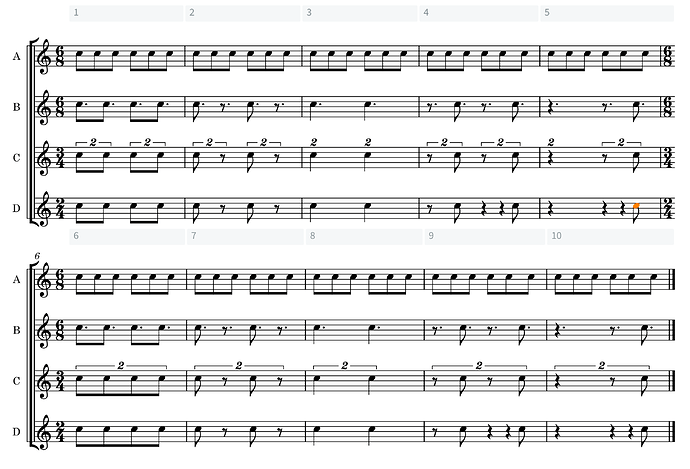I’ve been trying to do a 2/4 against 6/8 polymeter using the trick detailed in https://www.scoringnotes.com/tutorials/masking-meters-creating-polymeters-metric-modulations-dorico, whereby a polymeter is simulated using a bar with an anacrusis longer than the normal bar length, and hidden duplets within it. After inputting a bar of 2/4,3 to give a 2/4 time signature on a bar with three crotchets, and then adding a 2:3 duplet, the rests are shown as two minims rather than two crotchets, and if I then enter a quaver the rests in the remainder of the bar are of incorrect lengths. Moving the quaver around within the bar gives various other incorrect rest values, with only the third quaver position giving correct values.

The 2:3 tuplet you’re creating consists of two non-notatable durations; the divisions are 4/3, i.e. a note that is 1 and 1/3 quarter notes in length. Unsurprisingly Dorico cannot notate this. If I understand what you’re trying to do, make sure you are choosing an eighth note in the Notes panel before you create your tuplets.
Thanks Daniel, I’ve tried using eighth notes too, but get a similar result - and I think you may have misunderstood something, as I really don’t think I’m trying to get non-notatable durations, as I hope the example below will demonstrate.
The end result I’m trying to achieve is a 2/4 bar in one part the same length in time as a 6/8 bar in another part, which is a polymeter where notes of the same notated value have different lengths. I understand that presently Dorico is unable to do this natively, so it needs a bit of creative thinking, as detailed in the article I linked. In my case I’m creating a 2/4 bar with 3 beats in it by means of an anacrusis, (shift-M “2/4,3”). I then create a quarter note duplet, so 2 quarter notes in the time of 3, which should fit against the 6/8 bar perfectly. Indeed, if I do this with a 3/4 bar it works as expected, its only when I use a 2/4 with three beats that it stops working.
In the example below,
A is just straight 6/8 bars of quavers. Sorry, eighth notes…
B is the rhythm I’d like to achieve notated without duplets
C is the same rhythm notated as duplets in 3/4 time
D is the same as C, but with each bar having a hidden “2/4**,3**” time signature, and with the duplet numbers and brackets hidden
The first system uses duplets sourced from eighth notes
The second system uses duplets sourced from quarter notes
As you can see, C gives exactly the result I want in terms of note durations, but when I convert the time signature to “2/4,3” rather than “3/4” the durations of rests at the start of the second beat have incorrect durations (bars 4,5,9,10).
Unfortunately the music I’m trying to notate has its first bar similar to bars 5 or 10, so I can’t work around it by using “2/4,3” for the first bar, then hidden 3/4 (or 6/8) signatures for the remainder.
Your pics seems to mean that 2/4 = 3/4 , which implies that 2 = 3 , a computer will resist immidiately, because the two bars are of Equal length and the denominators , 4 in both fractions, can not be the same. Impossible in other Words.
Yes, that’s exactly what it has to look like - an eighth note in the 2/4 bar takes up the same amount of time as a dotted eighth in 6/8. It’s a common thing to want to do - in the example shown on ScoringNotes linked above, Bach does it with 12/8 and 4/4. I’ve also seen it in Jesu Joy of Man’s Desiring. In this particular instance I’m setting a Christmas carol in 6/8 against one in 2/4. It’s not impossible at all, just that the tempos in each line have to be different, but related so that the bar lines line up,
Dorico will do independent time signatures without a problem, so long as they are metrically equivalent. If there is a metric difference between the two, as here where quarter = dotted quarter, then Dorico can’t handle it (yet - I’m sure I’ve seen this promised for the future!).
So, to get this to look right we have to fool Dorico into giving us a 2/4 time signature on a bar with 3 quarter notes in it by using a 3 note anacrusis, and then use a duplet to get 2 quarter notes spread over the time of three, and then hide the duplet bracket and number. It all works perfectly until there is a rest at the start of the second beat, when things go a bit haywire and the rest lengths get notated incorrectly.
I’ve attached another screenshot showing how it’s supposed to look - basically the same thing but done the other way round (ignore line C - this is just showing my working!). This time the 2/4 bars are the base unadulterated ones, and the 6/8 bars are 4-eighths anacrusises (anacrusii?) with hidden triplets.
So, I can make it look (and sound) like it’s supposed to, but I still think there is a bug when doing it the other way.



